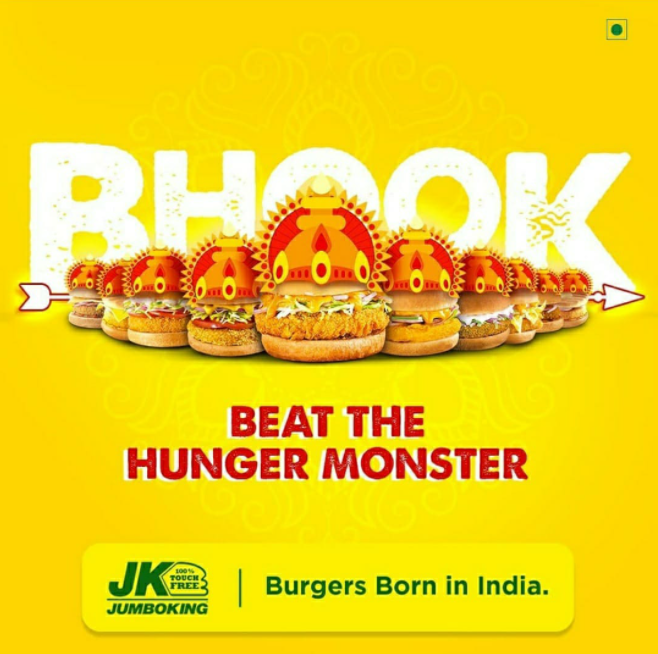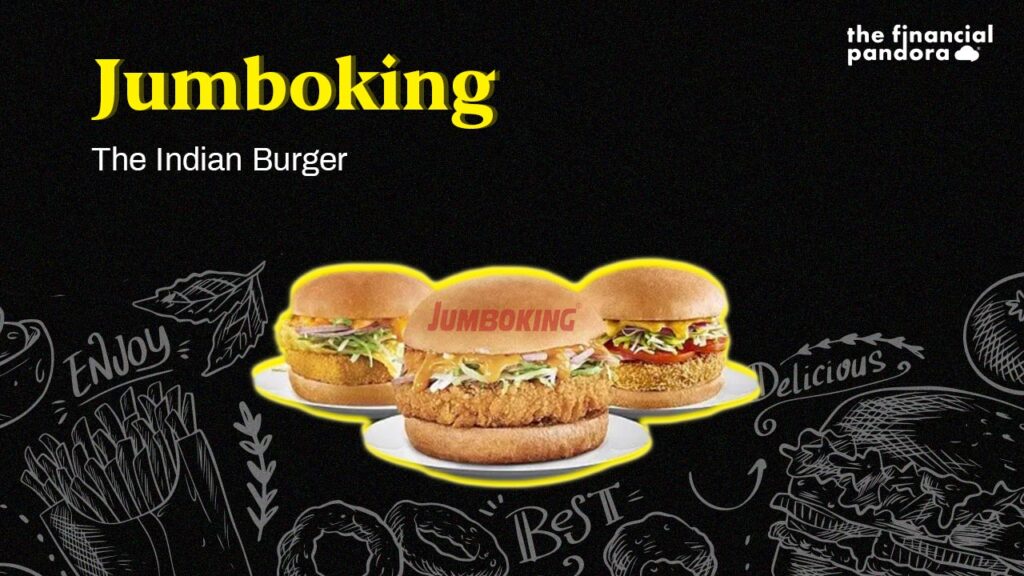Vada pav is often resonated with Mumbai. It is a go-to vegetarian snack that consists of a vada, a deep-fried potato patty inside a burger bun known as pav served along with spicy garlic and mint chutney. Dheeraj Gupta, Founder and Managing Director of Jumboking decided to position vada pav, the Indian street food as the ‘Indian Burger’.
How it all started?
Dheeraj Gupta, the Founder of Jumboking is a third-generation entrepreneur from his family. Every entrepreneur has their own story and so does the owner of Jumboking. After completing MBA, Mr. Gupta established a sweets manufacturing and distribution business intending to export the sweets to markets with a large Indian population like Dubai. Within two years, he lost ~INR 50 lakhs and had to close down the business. His next entrepreneurial venture was an eatery called Chaat Factory which had its first outlet in Malad, Mumbai, and with the successful running of the business, Mr. Gupta realized that the Maharashtrian snack, vada pav was the most sold food item on the menu. Later, he decided to continue his business with vada pav as the core product. Thereby, established the branded vada pav business Jumboking.
Journey so far
On 23rd August 2001, Jumboking opened its first outlet in Mumbai in 150-200 square feet space outside the Malad railway station. Dheeraj Gupta was inspired by the successful western fast-food chain model of McDonald’s, Dominoes, and Subway who primarily focused on one food product such as burger, pizza, and sandwiches, respectively. Though he was inspired by western, Jumboking sticks to the desi origin. Dheeraj Gupta applied the western model to Indian cuisine by launching Jumboking which aims to provide hygienic vada pav at affordable prices, delivered with good service quality, and adds value to the common man. The business slowly grew with word of mouth. Jumboking’s stores serve a wide variety of vada pavs incorporating flavors such as butter, schezwan, crispy veg, corn palak, nachos, along with serving ice cream (softy), veg wraps, patty, nuggets, shake, and soft beverages such as cold drinks and lassi.
The main target of the company is the sub-urban train traveler which led to most outlets opening close to railway stations and busy places where a constant stream of commuters was assured. With an initial investment of 2 lakhs, Jumboking earned a revenue of 40 Lakhs at the end of its first year. By 2005, Jumboking had five outlets in Mumbai. They decided to expand their presence in 2006 by opening an outlet in Surat, Gujarat. However, due to supply chain issues the store had to be closed down.
In 2007, Jumboking outsourced the production of patties to a manufacturer who produced ready to fry food options for a leading multinational food brand. The frozen patties were transported to various outlets and helped maintain quality across stores. By 2007 Jumboking had 32 stores which went up to 45 in 2008.
In the year 2010, 6.5 crore venture capital was raised from undisclosed sources. The business was struggling with overhead costs and unit economics. To grow the QSR (quick-service restaurant) business, Jumboking realigned the business model from company-owned stores to a franchise model. By 2012, Jumboking had 52 stores across thirteen cities in India, half of the stores were company-owned stores. The brand has sold 100 million vada pavs as of April 2014.
Currently, Jumboking operates through 114 franchise stores. It has a presence in Mumbai, Pune, Indore, Lucknow, and Ujjain. The stand-in and takeaway format chain launched its first seat in-store in Lucknow in 2009.
Business Model
Jumboking focuses on franchise driven business model. The brand converted company owned outlets that were not doing well into franchise-owned stores and currently operate with 114 franchise stores.
The investment involved to set up a franchise outlet is Rs 30 lakhs. The cost break-up includes a non-refundable one-time franchise fee of ₹4 lakhs + GST, refundable interest-free security deposit of ₹50,000, store set up cost of approximately INR 20 lakhs for an 250 sq. ft. carpet outlet and property deposit as applicable depending on the property size and location. The franchise agreement is valid for 20 years which is renewable after every 5 years. Once the franchise-owned store is set up, it pays a fixed 10% of the top line to the brand.
The franchise owners directly control all the expenses related to the store and hence ensure operations are tightly held. In 2009, when the brand converted its company-owned stores to franchisees, the sales increased by 30 percent and operating costs decreased by 40 percent and the store upkeep also improved. The franchisee staff is trained by the franchise owner and each franchisee ensures to instill a culture of customer service and store upkeep. Almost every franchise store of Jumboking has been profitable and in turn, helps in the growth of Jumboking. The franchisee stores have tied up with Zomato and Swiggy to expand the brand into online sales.
As per a YourStory article, Jumboking earned a revenue of $1 million in 2018 and $1.5 million as of 2020 and makes a net margin of 8%. The total revenue of the franchisee or the Gross Transaction Value shows that the revenue made by the brand was more than $8 million in 2018.
Focus on Technology
Jumboking has constantly invested in technology to better manage the supply chain based on consumption patterns. Jumboking’s manufacturing plants can churn out 1.8 tons of buns and patties per hour. Outsourcing helps to maintain standardization across outlets and also ensures outlets focus on growth and sales. Technology has enabled the brand to capture data on what sells at a particular outlet and leverages the data to predict what stocks need to be replenished. The data goes directly to the manufacturer, who fulfills the orders. The demand forecasting ability has helped the brand cut down costs.
Marketing
Jumboking popularized itself among its target audience of professionals, students, and commuters as a hygienic snack when in a hurry. The company’s logo and signage board are in the colour yellow and red which helps the customer retain some elements of the logo. The signage board and tag line are also delivered in regional languages. Pamphlets, newspaper advertising, and billboards displayed at strategic locations are the traditional advertising means to build brand equity.
Jumboking has a presence on almost all social media platforms. It often runs campaigns to spread awareness. #VadaPavDay was a campaign launched to celebrate their anniversary (23rd August).
Jumbo championship involved a vada pav eating competition at malls in Mumbai and Pune and the price of these contests would be gift vouchers or a Jumboking offer booklet.
#MereWalaVada campaign asked people to share recipes of their vada pav on the company’s website. The 30 best recipes were selected and published in a booklet available for purchase at all Jumboking outlets. The best recipe out of the 30 went ahead to be a part of the new Jumboking launch.
The brand also launched an offer called ‘JK of the day’ where each burger is available at a special price on a given day.
During IPL match days Jumboking offers 30% off on its delivery partners Swiggy and Zomato.
Through the #JoyofGivingwithJumboking initiative, the brand has collaborated with the Asian Heart Institute to distribute 40,000 burgers to slums where families are going hungry in Mumbai.
Jumboking keeping the brand’s desi recognition has embraced a new tagline – ‘Burgers born in India’.


Industry Variables
As per Businesswire, the Quick Service Restaurants (QSR) market in India is projected to grow at a CAGR of over 18% during 2021 – 2025 due to increasing urbanization, rapid expansion in food delivery services, expanding young & working population, a growing number of dual-income families and rising disposable income in the country.
The segment is a pure competitive market with organized and unorganized players. Jumboking competes with McDonald’s, Burger King, and Indian brands like Haldirams, Goli Vadapav, and Bikanerwala. The existing unorganized market competitors include roadside vendors, local food joints, and sweet shops serving snacks.
Resilience during the pandemic
Jumboking announced the ‘Restart 20’ a set of 20 measures to resume operations post the lockdown. As per Outlook India, Dheeraj Gupta is optimistic to see a V-shaped recovery. A V-shaped recovery is a quick and sustained recovery in measures of economic performance after a sharp decline.
Actions to be considered
Short term priorities should include maintaining physical distancing and sanitization regulations at outlets to continue generating sales. Serving customers through delivery aggregators like Swiggy and Zomato enables the brand to increase sales via online channels. Sending targeted customer communications is the key to engage with the target audience. During these tough times, managing cash is a clear priority. Scenario modeling and contingency planning will be among the main responsibilities which involve having access to real-time data on how the situation is evolving and plan accordingly.
Medium-term actions revolve around capturing the returning demand along with a focus on the supply chain. The brand should focus on preserve and grow strategy to continue by prioritizing on hygiene and safety while controlling costs.
Long term considerations of Jumboking should involve expanding and positioning the Maharashtrian snack across India and focus on the vadapower.
Follow Us @




